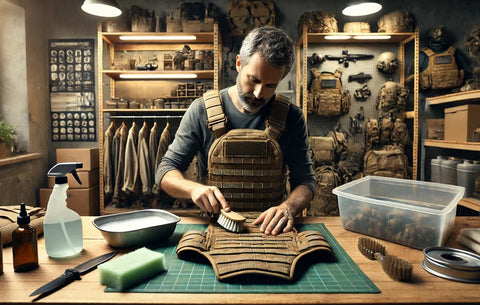Maintaining your plate carrier in optimal condition ensures your safety and comfort. Proper care is essential whether you are using a plate carrier as part of an official uniform or for fitness activities like those involving a Malinois Plate Carrier. This comprehensive guide will cover everything from routine cleaning tips to maintenance practices to help extend the life of your plate carrier.

For a deeper understanding of the safety aspects associated with your gear, be sure to review our Comprehensive Guide to Plate Carrier Safety, which covers essential safety checks and practices.
Routine Cleaning of Your Plate Carrier
What to Avoid
Understanding the cleaning practices you should avoid to prevent damaging your plate carrier. Here are some critical no-nos:
- Avoid Harsh Chemicals: Never use bleach, harsh detergents, or standard household cleaning products on your plate carrier. These can degrade the fabric and compromise the vest's integrity.
- Steer Clear of Machines: Do not place your plate carrier in a washing machine or dryer. Similarly, avoid fabric softeners as they can impair the fabric's performance.
Effective Cleaning Steps
To ensure a thorough clean without damaging your tactical plate carrier, follow these detailed steps:
- Pre-Clean: Begin by removing all plates and accessories. Brush off any loose dirt and debris to prevent grinding it into the fabric during washing. If you are still in the process of selecting your gear, you may find our Essential Guide to Selecting the Perfect Tactical Vest helpful. It offers tips on choosing the right vest for your needs, ensuring you start with equipment that’s easy to maintain.
- Spot Cleaning: Use a soft cloth and a mild detergent solution (like liquid dish soap mixed with water) for spot cleaning. Gently scrub any stains with a toothbrush or a soft brush, not using anything as harsh as a wire brush.
- Deep Clean: If the entire carrier needs cleaning, soak it in a bathtub with a mixture of liquid laundry detergent and warm water. Agitate the solution gently with your hands rather than using a hose, which could damage the fabric's fibers.
- Rinsing: Rinse the plate carrier in clean water to remove all soap. Change the water as needed until it is clear.
- Drying: After cleaning, reshape the carrier and let it air dry, preferably indoors or in a shaded area to avoid direct sunlight. Flip it periodically to ensure it dries evenly.
Maintenance and Storage Tips
Proper storage and ongoing maintenance are just as crucial as cleaning. Here's how to keep your plate carrier in top shape:
- Storage: Do not store your plate carrier in the trunk of your car, an old footlocker, or under a pile of clothes. These conditions can deform the carrier or degrade its materials.
- Handling Plates: If you use ceramic or SAPI plates, remove them when not in use to alleviate stress on the carrier's fabric.
- Hanging: Hang your plate carrier in a closet or on a dedicated hook between uses to keep it in shape and ready for use.
- Cover Up: For long-term storage, consider covering your plate carrier with plastic to protect it from dust and other environmental factors.
When setting up your tactical vest, avoid common pitfalls by consulting our Guide to Setting Up Your Tactical Vest: Avoid These Common Mistakes. This resource can help ensure you're assembling and maintaining your gear correctly, enhancing both functionality and lifespan.
Longevity Through Care
Taking proper care of your plate carrier ensures it lasts for years and remains functional and reliable. Whether for daily use or occasional wear, following these guidelines will help maintain your equipment in excellent condition, providing comfort, safety, and durability. Remember, the life of your plate carrier significantly depends on how well you maintain it, making these practices an essential aspect of its upkeep.
Frequently Asked Questions About Plate Carrier Care
1. How often should I clean my plate carrier?
Clean your plate carrier as needed based on frequency of use and exposure to dirt and debris. For regular users, a monthly cleaning is recommended, but spot clean as necessary to remove dirt and sweat in between thorough washes.
2. Can I use vinegar or baking soda for cleaning my plate carrier?
While vinegar and baking soda are great natural cleaners for many items, it's best to stick with a mild detergent for your plate carrier to avoid damaging the material or affecting its integrity.
3. What's the best way to dry a plate carrier after washing it?
Air drying is the safest method. Hang the carrier in a well-ventilated area away from direct sunlight. Avoid using heat or a tumble dryer as these can warp or shrink the fabrics and materials.
4. Is it necessary to remove the ballistic plates before cleaning the carrier?
Yes, always remove all plates and any other accessories. This not only makes the carrier easier to clean but also helps prevent damage to both the plates and the carrier.
5. How can I eliminate odors from my plate carrier?
After cleaning with a mild detergent, you can sprinkle baking soda on the damp carrier and leave it for a few hours before brushing it off and air drying. This can help absorb and neutralize odors.
6. Are there specific storage tips to prolong the life of my plate carrier?
Store your plate carrier in a cool, dry place out of direct sunlight. Hanging it on a padded hanger can help maintain its shape. Avoid compressing it under heavy items to prevent fabric damage and deformation.
7. Can I iron my plate carrier to remove wrinkles?
Ironing is not recommended as it can damage the carrier's materials. Most wrinkles should smooth out naturally if the carrier is hung properly after washing and drying.




